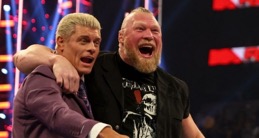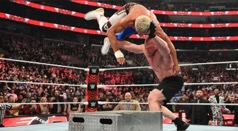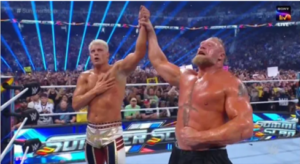WrestleMania marks the culmination of a year’s worth of storytelling. As WWE’s most pivotal event, it showcases blockbuster matches and championship victories that pave the way for upcoming storylines. These matches engage audiences, offering a glimpse into the journeys of new champions, former champions, and megastars. Among WWE’s annual shows, the Raw episode following WrestleMania holds distinct significance. Its importance lies in setting the stage for the company’s subsequent narrative arcs. The Raw after WrestleMania shapes the narrative landscape for future events. Well-constructed storylines attract substantial crowds to arenas and TV screens. Essentially, the Raw after WrestleMania stands as a crucial element that contributes to the overall success of WrestleMania itself.
There were a lot of rumors swirling around WWE on the Raw after WrestleMania 39. One of them was a merger between WWE and UFC, potentially forming a new company. At the start of the show, Paul Levesque walked in and assured the audience that this would certainly not happen. However, despite this hopeful beginning, the rest of the 2-hour and 18-minute show left many disappointed. According to cagematch.net, a database that provides ratings for pro wrestling shows, the post-WrestleMania Raw received a rating of 0.77 out of ten, making it the fourth lowest-rated WWE show and lowest-rated Raw of all time.
This drop in fan ratings coincided with Vince McMahon officially being back in charge. On Tuesday, ‘Fightful Select’ reported that Vince McMahon had changed scripts backstage, and the writers were still revising scripts even after the show had begun. This report particularly angered fans. It’s important to note that there is no evidence to confirm whether these script changes also included the Cody Rhodes, Roman Reigns, and Brock Lesnar segments. This essay does not assert such a thing; it is merely an examination of the lack of storytelling elements that could have provided a more dramatic and engaging feud for fans.
As Raw kicked off, Rhodes walked in and told Reigns that Reigns is still the champion only because of Solo Sikoa’s interference. Cody declared that he wanted a rematch. Soliciting a rematch as a loser has long been one of the best ways to carry a feud forward to the next event. At first, Roman Reigns refused Rhodes’ proposition, and looked for a way to get rid of it. He looked anxious, but suddenly “The Wiseman” Paul Heyman offered a new idea. The Wiseman’s suggestion complicated the segment. He proposed a tag team match for the Undisputed WWE Universal Championship against Solo Sikoa and Roman Reigns, but under one condition – if Rhodes lost, neither he, nor anyone who teamed up with him, would ever receive a chance to compete for the title.
Suddenly, Brock Lesnar’s entrance song played, startling both those in the arena and at home. Lesnar’s comeback was so dramatic because, after losing the title at WrestleMania 38 and losing at the 2022 SummerSlam, the “Beast Incarnate” was seeking an opportunity for revenge on the Tribal Chief. Brock Lesnar entered the ring and aligned himself with Rhodes, officially setting up the match for the final segment of the show.

Fans waited until the end of the show for what was supposed to be a great championship match. Yet, after their entrances, before the match even started, Brock Lesnar inexplicably launched an assault on his own teammate, Cody Rhodes. The surprising turn of events left Reigns and Sikoa stunned, prompting them to exit the ring as Brock relentlessly attacked Rhodes.

The episode’s low fan rating suggests that fans felt disappointed after this segment. Fans were promised a big match, but it was ruined. The feud between Rhodes and Lesnar continued at Backlash, Night of Champions, and SummerSlam. Rhodes emerged victorious at Backlash and SummerSlam, while Lesnar secured a win at Night of Champions. Unfortunately, throughout this period (from Raw after WrestleMania to SummerSlam), there was a lack of story development in this feud. Only one or two weeks before each event, they would confront and invade each other, resulting in a marginalization of the storyline on Raw.
From WrestleMania to SummerSlam, the WWE universe was involved in Brock Lesnar and Cody Rhodes feud. At SummerSlam, they competed for the third time with Rhodes taking the win. Undoubtedly, Brock Lesnar and Cody Rhodes are two WWE two mega stars. However, their feud would have been more interesting if it had begun with a clear, motivated, inciting incident. The lack of dramatized storytelling in the Rhodes-Lesnar feud can be traced to the Raw after WrestleMania.
In this next section, I identify the narrative components that can be harnessed to enhance dramatization to build meaningful feuds. This analysis will explore how these components function within a feud to generate a heightened level of excitement that resonates with audiences. Furthermore, I will propose an alternative strategy that can potentially bring us closer to achieving the intended goal.
Pro wrestling is a storytelling medium based upon classical narration, where above all, cause and effect is a prominent device for constructing a narrative. In classical narration, devices work through motivations, and these motivations induce the device to have a function. In our example, Rhodes’ long-standing dream of winning the Undisputed Championship was not fulfilled in the previous night’s match. As he declared upon coming back to WWE (WrestleMania 2022), he wants the title that his father Dusty Rhodes never obtained so as to rest his father’s soul in peace. This desire motivated Cody Rhodes to come face-to-face with Reigns again.
Every well-written story is crafted through a series of meticulously planned steps, with each subsequent step building upon the previous. From the initial action to the final resolution, each element must seamlessly integrate to form a cohesive narrative. When scrutinizing a story’s weaknesses, it’s essential to methodically categorize its components. This is precisely the approach I intend to take with our example. I aim to demonstrate how components build a story from beginning to end, and, in this process, illustrate how unsuitable components can create gaps in the storytelling. I will segment our example into two distinct sections. The first section examines the show opening in which Rhodes, Reigns, Lesnar, The Wiseman, and Sikoa gather in the ring to construct and advance the storyline regarding the fate of the Undisputed Universal Championship. The second focuses on the concluding portion of the show, where they reunite in preparation for the match, and outlines how the components of the storyline in the second segment did not complete the fantastic plot of the first segment.
Let’s return to the beginning of this feud. Rhodes made his appearance on Raw to address his loss from the previous night. The inception of the narrative occurred when he expressed his desire for a rematch, driven by his personal motivations. This act of requesting a rematch marked the first action in the story. Inasmuch as storytelling in pro wrestling engages multiple characters, the first action introduces the second character to the story. In fact, The Wiseman’s presence is the function of Rhodes’ device and as it is marked as Diagram 1, the function of the first character converts to the device of the second character. Likewise, the function of Wiseman’s device brings the third character and his presence is a helpful device to lead the story. Up to this point, there is no gap in the story. However, as depicted in the Diagram 2, after the stars come to the ring, before the match is started, Lesnar attacked Rhodes. This attack leads this feud to the next level. Audiences thought that Lesnar and Rhodes were aligned together, but suddenly things changed. Lesnar’s attack was the feud’s turning point, shifting the narrative from Reigns vs. Rhodes to Lesnar vs. Rhodes. Roman Reigns was eliminated from this feud skillfully and left the ring with The Wiseman and Solo Sikoa. But Brock’s motivation did not unfold. It is the most prominent gap in this story and the root of not well-written story comes from here. From this show to Backlash, no further developments took place, and the rationale behind Brock’s attack remained undisclosed.
I have demonstrated where the main problem lies, and now, I aim to present an alternative that could provide motivation for Brock’s attack. It is an option that WWE has employed countless times in its shows. The match should commence with Rhodes and Lesnar initially collaborating well, dominating their rivals. However, as the match progresses, they encounter issues with each other. One narrative device that WWE has frequently used involves teammates turning on each other due to tag-team problems. In our case, for example, Lesnar could refuse to tag Rhodes because he doesn’t want to leave the ring, or Lesnar could touch Rhodes to come into the ring against Rhodes’ desire. This discord ultimately results in their defeat against Reigns and Sikoa. Following the loss, an enraged Brock Lesnar abruptly launches an attack against Cody. This attack is motivated by Lesnar’s perception that Rhodes is to blame for their loss. As Lesnar loses the match against Reigns for the third time, he holds Rhodes responsible.
Conclusion
Employing the trilogy of device/motivation/function is a fundamental component for analyzing classical narrative media. This approach doesn’t solely encompass the narrative aspect; it can also be applied to visual elements, such as camera angles, lighting, and camera movement. As evident in this context, this framework serves as a guiding template, illustrating both the current state and the anticipated trajectory of the narrative. Notably, the caliber of the device/motivation/function trio directly influences the quality of a story. Particularly when applied to the backgrounds of character feuds, this trilogy can magnify and intensify the excitement that emanates from a narrative.

WWE misused these two megastars. With a well-written story, their feud could be even more popular than the bloodline’s story. At SummerSlam, these megastars, each of whom can bring thousands of people to the arena, confronted each other for the third time. However, their confrontation seemed to be for nothing, and it became quite tedious. Following their match, Brock Lesnar and Cody Rhodes embraced, signaling that this feud has reached its conclusion.
-Ehssan Zamani (zamaniehssan2@gmail.com)

